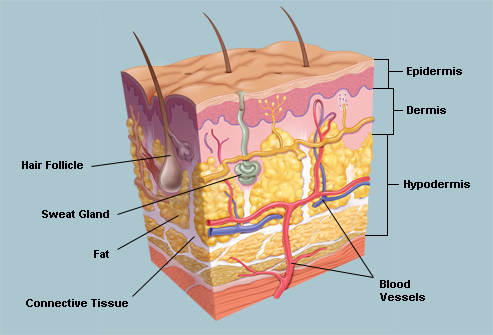The Integumentary System
The Integumentary system is the skin and all of its components. There are 3 different subsections of the skin, the epidermis, or the outermost layer, the dermis, or the middle layer, and the hypodermis, which is the innermost layer. Each layer has different structures and functions to help us in our daily lives. One of the functions of the Integumentary system is protection. The skin protects our bodies from unwanted bacteria that exists outside our bodies, as well as protects us from impact with the fatty layer in the hypodermis. Our skin also synthesizes Vitamin D, which is taken into the body and changed into calcitrol by the liver and kidneys, and helps us to regulate the calcium and phosphorous in our bodies. The skin is also responsible for sensory reception, as nerve endings are scattered throughout our bodies, receiving impulses such as touch, pressure, pain, and temperature in the dermis layer of our skin. Sweat glands are scattered throughout all 3 layers of our skin and are responsible for keeping us cool. Through evaporative cooling, we are able to keep our bodies cool even when exercising or when our surroundings increase in temperature.
Above is the structure of the skin with all of the elements labeled.
The innermost layer is called the subcutaneous layer or the hypodermis. The hypodermis contains fat cells and is largely involved in protecting the body from impact, as well as insulating the body and storing energy. The middle layer is called the dermis, and has connective tissue within it. This connective tissue is flexible enough to allow us to move but strong enough to keep the body safe. The dermis layer is also where nerve impulses are recieved. The root of hair follicles are located in the dermis layer, as well as sebaceous glands that produce oil and act as "waterproofing" substances for our skin. They keep the water that we have in our bodies in by releasing oil into the hair follicle that insulates the area.
The outermost layer is called the epidermis. The epidermis receives nerve impulses and has nerve endings throughout the body. The epidermis is a thin layer that is mostly responsible for the protection from bacteria outside the body, as well as melanin production to protect our bodies from the sun's UV rays that can damage our internal and external structures and cause mutations in our DNA.
The innermost layer is called the subcutaneous layer or the hypodermis. The hypodermis contains fat cells and is largely involved in protecting the body from impact, as well as insulating the body and storing energy. The middle layer is called the dermis, and has connective tissue within it. This connective tissue is flexible enough to allow us to move but strong enough to keep the body safe. The dermis layer is also where nerve impulses are recieved. The root of hair follicles are located in the dermis layer, as well as sebaceous glands that produce oil and act as "waterproofing" substances for our skin. They keep the water that we have in our bodies in by releasing oil into the hair follicle that insulates the area.
The outermost layer is called the epidermis. The epidermis receives nerve impulses and has nerve endings throughout the body. The epidermis is a thin layer that is mostly responsible for the protection from bacteria outside the body, as well as melanin production to protect our bodies from the sun's UV rays that can damage our internal and external structures and cause mutations in our DNA.

